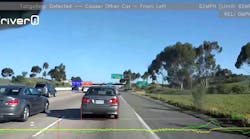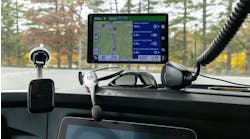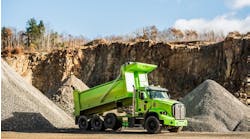In the last two decades, trucks have transformed before our eyes, becoming leaps more technologically advanced and computer-controlled along with their vehicle siblings across the broader automotive world. Setting them apart from passenger cars, big commercial trucks have many more reasons and opportunities to monitor data and ways to improve and streamline operations.
They come in many varieties, but all such trucks represent a sizeable equipment and asset investment, from truck to cargo and driver, that's ultimately at risk in transit and operations. Businesses naturally want to minimize costs and losses while maximizing efficiency and gains, and fleet managers have been staring at dashboards of data from transportation management systems for years trying to do that.
It was bound to happen: as the state of truck and fleet technology advanced in terms of hardware, software, and connectivity linking it all, we've reached a point where fleet management can quickly become like an email inbox getting inundated with messages. You could spend all day just trying to keep up.
Similarly, a fleet manager could easily spend every minute of the day trying to monitor and interpret all the potentially actionable data coming from the business' trucks to wring out worthwhile gains. It'd be worth it—but there are many changing factors and a fleet is literally a moving target, so keeping things optimized means lots of diligence, calculation, and follow-through.
For example, safer, more highly-skilled drivers can reduce fuel spend, put less wear on trucks, help reduce vehicle maintenance required, and potentially save considerable time and money by avoiding preventable accidents and resulting claims. Smarter, streamlined routes mean more deliveries, shorter transit times, and ultimately less wear on trucks and accompanying maintenance with fewer miles traveled.
Find and fix a problem sooner and it often costs less. If a fleet system can recognize particular patterns, combinations, and/or frequencies of fault codes on trucks that occur prior to equipment failures and provide the fleet more advanced notice that something's wrong, it can often mean reduced repair time and cost. There are other related benefits like lessened potential hits from lost business and interruptions to driver pay and fleet utilization.
You could go on and on. As trucks have been advancing technologically and doing so at a faster rate, it's reasonable to say that using data to drive higher productivity has become a necessity as transportation demands have changed and grown. But huge heaps and piles of data aren't readily helpful.
They can become more of a nuisance and hindrance, actually—especially if all the data requires hefty man hours from the fleet manager, for example, to get good ROI. Whole companies exist today because they found a way to use fleet truck data to shave a cent or fraction thereof off every loaded mile.
Unburdened from data
Artificial intelligence, or AI, has become a fleet manager's best friend. It's the digital assistant that can help fleets get more out of their truck data and act on it more, capitalizing on the latest advancements in trucking technology: telematics, transportation management, dynamic routing, asset-tracking, Internet of Things sensors and systems, video monitoring, advanced safety systems, and more.
AI also benefits the fleet at large, including drivers and other workers, by improving efficiencies, protecting equipment, and boosting profitability. But a large part of this is just to help fleets get the most out of their transportation management systems.
"Now that you have all this information, how can you apply it to your business?" Adam Kahn, vice president for fleets at camera-based safety systems provider Netradyne, said discussing the use of AI. A primary goal of artificial intelligence is getting machines and systems to do things without some person having to — the "artificial" in this case particularly refers to a man-made system.
In a rudimentary example, think of manufacturing a piece of hardware such as metal washers; now consider making a sorting system by adding different-sized holes in a sifting box where a variety of manufactured washers were collected. It could sort washers without anyone having to do it manually.
So with all of the advanced technological systems on a truck and data available to act upon today, what could AI help accomplish? There's far more than engine control module data available from trucks. Many other sensors and systems can be added, including video-based safety systems like Netradyne's Driveri product.
And there are many things such systems can add to support fleet operations without a person having to do anything, thanks now to advances including camera recognition. Beyond recording video, Netradyne's system can detect when a vehicle ahead is too close, for example.
"We see everything that's going on outside on the road, so we can provide a real-time notification that says, 'beep beep beep,' you're too close — or you're really too close," Kahn explained. The system can detect and track things like lane lines and road signs to monitor driver performance and similarly provide prompts or warnings where necessary.
"These are all cognitive, soft notifications that can happen because of the processing that happens in real-time at the device," Kahn said. "Now I'm turning that into actionable things with the driver," he added, noting that fleets can fine-tune what their "AI assistants" are watching for.
He gave the example of a fuel-hauling fleet whose trucks are required to stop at all railroad crossings for safety reasons. That fleet could set up a "railroad crossing" alert that would sound in the cab if one of the drivers rolled through a crossing without stopping properly.
"If I'm hearing, 'Railroad crossing, railroad crossing,' it's probably annoying," said Kahn. "I'm going to figure out how I won't have to hear that anymore — I'm going to stop at that next railroad crossing. And that's a low-pressure, really easy way for you to utilize the technology."
Another way is for the system to recognize if a driver is having a problem and automate remedial coaching. "Suppose I have a driver with eight rolling stops for the month," Kahn noted. "Instead of bringing them in for coaching, I can enroll them in supportive online training. Now you're in 'rolling stop school.'"
It's a few examples of how AI can improve fleet operations without the fleet manager having to lift a finger or spend a moment of his or her time. "You can do all this without having to go in to safety and do one-on-one meetings and look through videos," Kahn contended.




